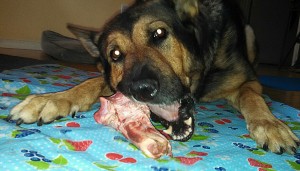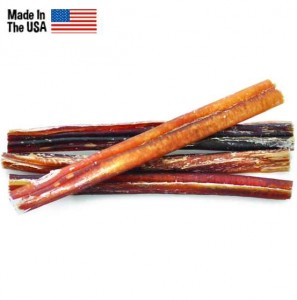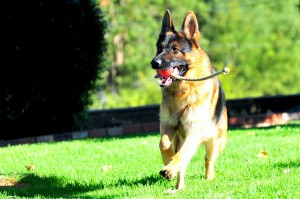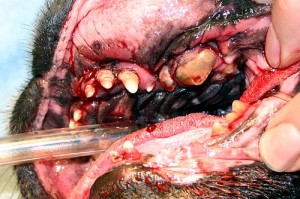When Diet Isn’t Enough
When a dog’s diet includes raw meaty bones, daily brushing and flossing of the teeth naturally occur as the dog consumes his food. But in dogs fed ground raw, pre-made raw foods, home-cooked diets, or commercial kibbled or wet food, this daily brushing and flossing is absent. Thus, various secondary prevention measures will be necessary to help keep teeth and gums in top condition. Let’s take a closer look at some of the most commonly recommended ways to keep a dog’s teeth and gums healthy.
Toys, Bones, and Treats
Feeding large raw knuckle or marrow bones is a popular option for helping keep teeth clean, as they provide extended chewing sessions and an abrasive action that wears away the tartar on the teeth. However, these dense bones have also been known to fracture enamel and break teeth. For dogs that can actually consume the knuckle bone, ingesting that much bone can result in constipation or even impaction. If you are set on feeding knuckle or marrow bones, avoid bare naked bones if possible (look for ones with meat, cartilage, tendons, etc.), and do not let the dog consume the entire bone. And be on the lookout for any signs of a tooth fracture, such as the dog favoring one side over the other. These dense bones have earned the reputation as ‘tooth wreckers’ for a reason!
Avoid overly hard toys, sterilized bones, cooked bones, and many of the special “teeth cleaning” treats. Hard toys (like many of the hard plastic or nylon bones) and sterilized bones are too hard for teeth, and can chip, fracture, and wear down teeth abnormally. The hard nylon bones also flake off in sharp little slivers that can cut and slice sensitive gum tissue. Cooked bones splinter and can cause damage to the mouth, esophagus, stomach, and intestines. And many of these “teeth cleaning” treats are just junk food, and really do little cleaning at all for the dog. Most of these treats are made from nothing but various grain by-products and starches, such as wheat starch, corn by-products, potato starch, oat fiber, rice flour, and pea flour. They last for only a few seconds for most dogs, making their “teeth cleaning” effects negligible, as dogs need extended chewing time on a regular basis to keep their teeth clean and their gums in top condition. A few crunches on a starchy faux-toothbrush treat is not going to cut it.
 Beef tendons and bully sticks can be good for cleaning teeth and massaging gums for some dogs, if these treats last more than a minute or two for your dog (Note: if your dog tries to swallow the last few inches of the bully stick, you can train him to relinquish the stick when he reaches the end in exchange for some yummy treats.)! Avoid feeding the bully sticks that are brittle and crispy, as they break off in large chunks and do not do much for actual tooth cleaning. Dried beef trachea and lungs also tend to be too crispy and brittle to do much for teeth cleaning (and the sharp pieces can also slice sensitive gum tissue). Cow hooves and rawhides can also be problematic; cow hooves can break into smaller sharp pieces that the dog swallows, and the hooves do not digest well. Rawhides are not only full of many toxic chemicals used in the making of the product, but are also usually sourced outside the U.S. and have dubious origins (for more information on selecting safe treats, see our blog “Are Your Dog Treats Safe?“). Additionally, chunks of rawhide have been implicated in intestinal blockages. They swell in the throat, stomach, and intestines, and are not digested well by the dog. Choose your dog’s consumable chew treats wisely!
Beef tendons and bully sticks can be good for cleaning teeth and massaging gums for some dogs, if these treats last more than a minute or two for your dog (Note: if your dog tries to swallow the last few inches of the bully stick, you can train him to relinquish the stick when he reaches the end in exchange for some yummy treats.)! Avoid feeding the bully sticks that are brittle and crispy, as they break off in large chunks and do not do much for actual tooth cleaning. Dried beef trachea and lungs also tend to be too crispy and brittle to do much for teeth cleaning (and the sharp pieces can also slice sensitive gum tissue). Cow hooves and rawhides can also be problematic; cow hooves can break into smaller sharp pieces that the dog swallows, and the hooves do not digest well. Rawhides are not only full of many toxic chemicals used in the making of the product, but are also usually sourced outside the U.S. and have dubious origins (for more information on selecting safe treats, see our blog “Are Your Dog Treats Safe?“). Additionally, chunks of rawhide have been implicated in intestinal blockages. They swell in the throat, stomach, and intestines, and are not digested well by the dog. Choose your dog’s consumable chew treats wisely!
 Rubber toys can satisfy the dog’s urge to chew, but usually have a minor role in cleaning teeth and massaging gums. Some of the most durable rubber toys include Kongs, Jolly Pets Jolly Bone, and Bionic Play products. Ideally, the dog should chew on these toys daily in order to get the most benefit from them. Rope toys have been recommended on occasion for helping “floss” teeth, but if you have a dog that will chew, destroy, and swallow pieces of these toys, don’t use them! The pieces of rope can cause problems once ingested (ranging from vomiting to blockages to tangling in the intestines), so it is best to avoid these as a “chew toy”. Some people use them as a tug toy, but we prefer using a material that will not tangle around or catch the dog’s teeth (such as a tightly woven jute tug or linen or suede tug).
Rubber toys can satisfy the dog’s urge to chew, but usually have a minor role in cleaning teeth and massaging gums. Some of the most durable rubber toys include Kongs, Jolly Pets Jolly Bone, and Bionic Play products. Ideally, the dog should chew on these toys daily in order to get the most benefit from them. Rope toys have been recommended on occasion for helping “floss” teeth, but if you have a dog that will chew, destroy, and swallow pieces of these toys, don’t use them! The pieces of rope can cause problems once ingested (ranging from vomiting to blockages to tangling in the intestines), so it is best to avoid these as a “chew toy”. Some people use them as a tug toy, but we prefer using a material that will not tangle around or catch the dog’s teeth (such as a tightly woven jute tug or linen or suede tug).
Always supervise your dog when he is chewing on bones, toys, or treats, and always check toys for signs of wear and tear. Replace them if they are starting to show signs of damage.
Tooth Brushing
For dogs fed an appropriate diet that includes raw meaty bones, tooth brushing is most likely unnecessary, as the dog ‘brushes and flosses’ his teeth with every meal, and massages his gums as he chews. But if you feed only ground raw/pre-made raw food, or a commercial pet food, you will need to do a little tooth brushing to keep those teeth clean. The goal is to clean off the plaque buildup before it has a chance to harden, and before it builds up enough to cause gum inflammation and tissue decay. There are a few guidelines to follow when cleaning your dog’s teeth:
First, never use human toothpaste to clean your dog’s teeth! Use a specially formulated canine toothpaste, as human toothpastes can be toxic to dogs and contain chemicals that are very irritating to the dog’s stomach.
Second, use a soft toothbrush designed for the dog’s teeth, or use one of the rubber finger brushes. Brush gently, and don’t “jam” the brush around the dog’s mouth. You want to gently brush along the gum line to remove any food residue before it hardens into tartar. Another quick option is to wrap your finger in a paper towel or piece of gauze for a quick clean. This is effective for doing a quick “swipe” of the teeth along the gum line after a meal on days you don’t want to do a full brushing. You may be amazed at how much junk you pick up after the dog’s meal of kibble or ground raw food. Wiping off the teeth before the plaque has a chance to harden into tartar can be helpful in keeping those teeth clean.
Third, aim to brush at least once a week, although three or four times a week is better. This will help keep the tartar from developing into hard dental calculus. However, a dog fed a processed diet may still need professional veterinary dentistry at some point in their life as they age.
Veterinary Dentistry
 For dogs whose mouths are in dire condition, veterinary dentistry will be a necessity, although ideally owners should not wait until their dog’s mouth is in poor condition (such as this poor Pug pictured here). Some vets recommend yearly dental cleanings for your pet, perhaps in addition to feeding special “dental foods” that ‘clean teeth’ better than traditional kibbles or that contain tartar softening ingredients (see our previous blog on the importance of diet in maintaining dental health to address this issue). Veterinary dentistry may also be necessary if the dog cracks or breaks a tooth (a common problem in our active IPO/Schutzhund dogs and many other active breeds, regardless of diet).
For dogs whose mouths are in dire condition, veterinary dentistry will be a necessity, although ideally owners should not wait until their dog’s mouth is in poor condition (such as this poor Pug pictured here). Some vets recommend yearly dental cleanings for your pet, perhaps in addition to feeding special “dental foods” that ‘clean teeth’ better than traditional kibbles or that contain tartar softening ingredients (see our previous blog on the importance of diet in maintaining dental health to address this issue). Veterinary dentistry may also be necessary if the dog cracks or breaks a tooth (a common problem in our active IPO/Schutzhund dogs and many other active breeds, regardless of diet).
The dental cleanings performed by most vets involves anesthetizing the dog and then scaling the hard tartar off the teeth and below the gum line. The periodontal pockets in the gum line are cleaned out as well, as this is where periodontal disease develops. The teeth are then polished as a final step. This type of teeth cleaning can be expensive, and can cause much stress to the animal (having to be brought to the vet’s office, anesthetized, kenneled at the vet’s while recovering from anesthesia, etc.), but it most likely will become necessary at some point if a dog is fed a processed diet its entire life. Ideally, this dental cleaning can be performed if the dog is ever under anesthesia for another purpose, such as a spay or neuter surgery. There are anesthesia-free cleanings available, but these should only be performed by an actual veterinarian, and it may not effectively clean out the periodontal pockets below the gum line, as it is very challenging to get a canine patient to comply with dental scalings without anesthesia.
The results from these cleanings will only last for a short time unless there is a change in diet or a change in providing other secondary preventive measures. It is best not to let your dog’s teeth get to the point where he needs to be knocked out under anesthesia in order to have major work done on his teeth. Thus, taking measures now can help keep his teeth and gums clean and healthy for the long run.

